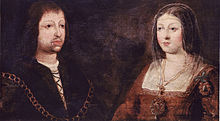
Back Katolieke Konings Afrikaans الملكان الكاثوليكيان Arabic الملوك الكاتوليك ARZ Reis Católicos AST Каталіцкія каралі Byelorussian Каталіцкія манархі BE-X-OLD Rouaned katolik Breton Katolički kraljevi BS Reis Catòlics Catalan Katolická Veličenstva Czech

| History of Spain |
|---|
 |
| Timeline |
The Catholic Monarchs[a][b] were Queen Isabella I of Castile (r. 1474–1504)[1] and King Ferdinand II of Aragon (r. 1479–1516), whose marriage and joint rule marked the de facto unification of Spain.[2] They were both from the House of Trastámara and were second cousins, being both descended from John I of Castile; to remove the obstacle that this consanguinity would otherwise have posed to their marriage under canon law, they were given a papal dispensation by Sixtus IV. They married on October 19, 1469, in the city of Valladolid; Isabella was 18 years old and Ferdinand a year younger. Most scholars generally accept that the unification of Spain can essentially be traced back to the marriage of Ferdinand and Isabella. Their reign was called by W.H. Prescott "the most glorious epoch in the annals of Spain".[3]
Spain was formed as a dynastic union of two crowns rather than a unitary state, as Castile and Aragon remained separate kingdoms until the Nueva Planta decrees of 1707–16. The court of Ferdinand and Isabella was constantly on the move, in order to bolster local support for the crown from local feudal lords. The title of "Catholic King and Queen" was officially bestowed on Ferdinand and Isabella by Pope Alexander VI in 1494,[4] in recognition of their defence of the Catholic faith within their realms.
Cite error: There are <ref group=lower-alpha> tags or {{efn}} templates on this page, but the references will not show without a {{reflist|group=lower-alpha}} template or {{notelist}} template (see the help page).
- ^ "Catholic Encyclopedia: Isabella I". Newadvent.org. 1910-10-01. Retrieved 2014-03-01.
- ^ Bethany Aram, "Monarchs of Spain" in Iberia and the Americas, vol. 2, p. 725. Santa Barbara: ABC Clio 2006.
- ^ Elliott, J. H. (2002). Imperial Spain 1469-1716. Penguin UK. p. 146. ISBN 978-0-14-192557-8.
- ^ Kamen, H. (2005). Spain 1469–1714: A Society of Conflict. Routledge:Oxford. p. 37.